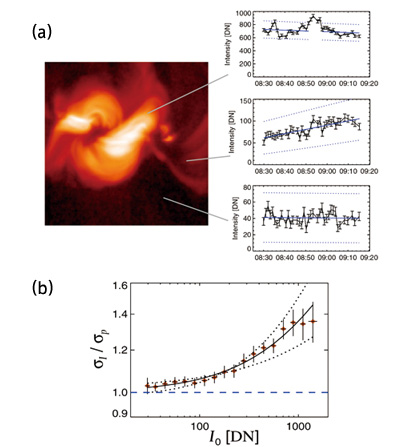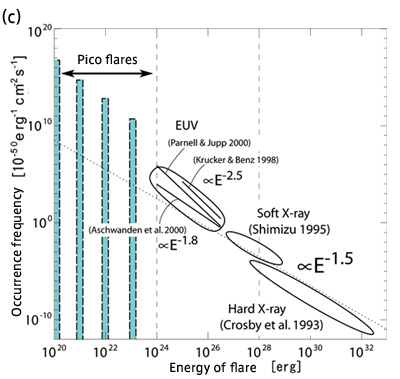TOP > Report & Column > The Forefront of Space Science > 2009 > Mystery of Solar Coronal Heating Being Explored by Satellites
![]()

Minute fluctuations in X-ray intensity and nanoflare X-rays coming from solar corona are not constant but always fluctuate. When sudden explosions like flares or micro-flares occur, an increase in X-ray brightness by more than one order of magnitude is observed. However, with more detailed observation, we were able to discover that fluctuations arose even when and where no explosions occurred. In the past, there has been no quantitative research about such minute fluctuations. The Soft X-ray Telescope (SXT) onboard YOHKOH is an extremely well calibrated observation instrument, allowing us to measure magnitude of noise caused by instruments with high accuracy. It enables us to measure fluctuations in the intensity of X-rays that originated in the Sun based on the size of the fluctuations observed. As a result, we were able to prove that fluctuations significantly larger than noise exist in the corona, especially in the very active coronal activity area, even if the area seems to be quiet. If we assume that the fluctuations are caused by superposition of an infinite number of nanoflares, we can estimate energy of each nanoflare based on the brightness of the corona and the magnitude of fluctuation. This is because the magnitude of the fluctuations increases as energy for each nanoflare increases. The energy estimated from the fluctuation observed by YOHKOH SXT was from 1020 to 1023 erg*. The energy of large explosive phenomena such as flares and micro-flares is from 1027 to 1033 erg. A comparison with these larger phenomena suggests the possibility that explosive phenomena smaller by several orders of magnitude (i.e. picoflares smaller than nano ones) occur frequently to heat coronas. *Erg: 1 erg means work amount when force of 1dyn (10-5N) moves an object 1cm in the direction of the force. 1 erg=10-7J  
Great power of high-resolution observation realized by HINODE The Solar Optical Telescope (SOT) onboard HINODE is a space telescope for solar observation with the world’s highest resolution. SOT makes possible the resolution and visualization of plasma phenomena that were previously impossible to distinguish. Particularly, in the chromosphere between photosphere and corona, it enables the identification of a number of small-scale phenomena that were invisible in the past. One example is penumbral microjets, which are tiny, short-life jet phenomena arising within sunspots. They are minute in both spatial and temporal range: 1,000 to 3,000km in length, about 400km in width, with a lifespan of less than 1 minute. They were identified for the first time by high-resolution observations of HINODE SOT. 
|
||||||||||||||||||||




